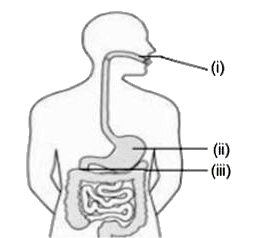Identify the correct set which shows name of the enzymes from where it is secreted and substrafe upon which it acts
pepsin-stomach-protein
ptyalin-intestine-maltose
chymotrypsin-salivary gland-Jactose
ptyalin-pancreas-lipid
The correct Answer is:A
To solve the question regarding the correct set of enzyme, secretion site, and substrate, we will analyze each option step by step.
1. Understanding the Question: We need to identify the correct set that includes the name of an enzyme, where it is secreted, and the substrate it acts upon.
2. Analyzing Option A:
- Enzyme: Pepsin
- Where Secreted: Stomach
- Substrate: Proteins
- Explanation: Pepsin is secreted in the stomach as pepsinogen (inactive form) and is activated by hydrochloric acid (HCl). It acts on proteins, breaking them down into smaller peptides.
- Conclusion: This option is correct.
3. Analyzing Option B:
- Enzyme: Salivary Amylase (also referred to as Tylenol)
- Where Secreted: Buccal cavity (mouth)
- Substrate: Starch
- Explanation: Salivary amylase is indeed secreted in the buccal cavity and acts on starch, converting it into maltose. However, the name "Tylenol" is incorrect as it refers to a pain reliever (acetaminophen) and not an enzyme. Therefore, this option is incorrect.
4. Analyzing Option C:
- Enzyme: Chemotrypsin
- Where Secreted: Salivary glands (incorrect)
- Substrate: Lactose (incorrect)
- Explanation: Chemotrypsin is produced in the pancreas and acts on proteins, not lactose. This option is incorrect due to both the secretion site and substrate being wrong.
5. Analyzing Option D:
- Enzyme: Salivary Amylase (Tylenol)
- Where Secreted: Pancreas (incorrect)
- Substrate: Lipid (incorrect)
- Explanation: This option incorrectly states that salivary amylase is secreted from the pancreas and acts on lipids. Salivary amylase is secreted from the salivary glands and acts on starch. Therefore, this option is also incorrect.
Final Conclusion:
The correct answer is Option A: Pepsin, secreted in the stomach, acting on proteins.
- Enzyme: Pepsin
- Where Secreted: Stomach
- Substrate: Proteins
- Explanation: Pepsin is secreted in the stomach as pepsinogen (inactive form) and is activated by hydrochloric acid (HCl). It acts on proteins, breaking them down into smaller peptides.
- Conclusion: This option is correct.
- Enzyme: Salivary Amylase (also referred to as Tylenol)
- Where Secreted: Buccal cavity (mouth)
- Substrate: Starch
- Explanation: Salivary amylase is indeed secreted in the buccal cavity and acts on starch, converting it into maltose. However, the name "Tylenol" is incorrect as it refers to a pain reliever (acetaminophen) and not an enzyme. Therefore, this option is incorrect.
- Enzyme: Chemotrypsin
- Where Secreted: Salivary glands (incorrect)
- Substrate: Lactose (incorrect)
- Explanation: Chemotrypsin is produced in the pancreas and acts on proteins, not lactose. This option is incorrect due to both the secretion site and substrate being wrong.
- Enzyme: Salivary Amylase (Tylenol)
- Where Secreted: Pancreas (incorrect)
- Substrate: Lipid (incorrect)
- Explanation: This option incorrectly states that salivary amylase is secreted from the pancreas and acts on lipids. Salivary amylase is secreted from the salivary glands and acts on starch. Therefore, this option is also incorrect.
The correct answer is Option A: Pepsin, secreted in the stomach, acting on proteins.
Similar Questions
Knowledge Check
Identify the correct set which shows the same of enzymes from where it is secreted and substrate upon which it acts
APepsin-stomach wall-caseinBPtyalin-intestine-maltoseCChymotrypsin-salivary gland-lactoseDPtyalin-pancreas-lipid CoAIdentify the statement which is not true for restriction enzymes ?
ASome 900 restriction enzymes have been isolated till dateBThey cut each of the two strands of DNA at spe- cific points through their sugar phosphate back- boneCThe naming of restriction enzymes follows the se- quence strain name follow ed by species name fol- lowed by genus nameDThe restriction enzymes can be both exonucleases as well as endonucleasesIdentify the statement which is correct from the following
ARate of reaction increases substantially with increases in temperature since frequency of collision increases.BRate of reaction decreases on increasing temperature if the reaction is exothermic.CRate of reaction remains unchanged if temperature changes for reactions having no activation energy.DRate of reactions decreases on decreasing temperature only if the reaction is endothermic
Identify the option that indicates the correct enzyme that is secreted in location A, B and C.

View Solution(i) As a digestive gland, liver secretes what? Where is this secretion stored? Name the enzymes secreted by liver.
(ii) Digestive secretion of liver contains which salts? What is their function?
View SolutionWhich of the following is the correct matchin of the site of action on the given substrate, the enzyme acting state upon it and the end product
View SolutionEnzyme which does not directly act upon food substrate is
View SolutionSteapsin is an enzyme which acts on
View Solution